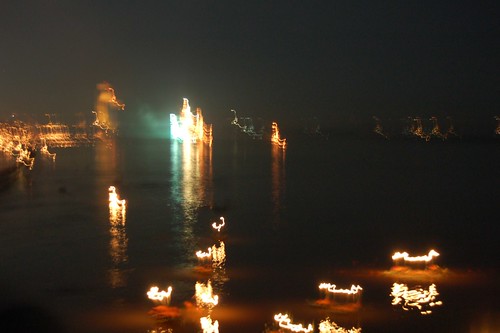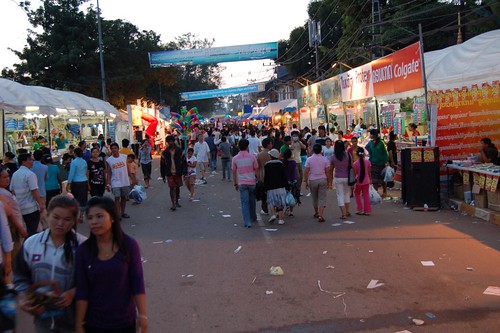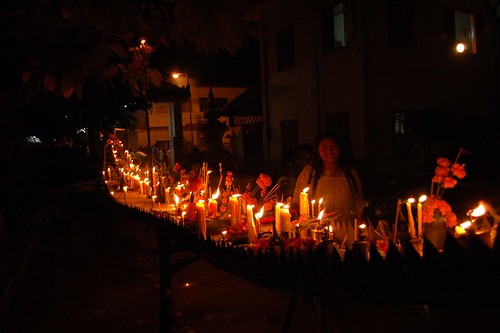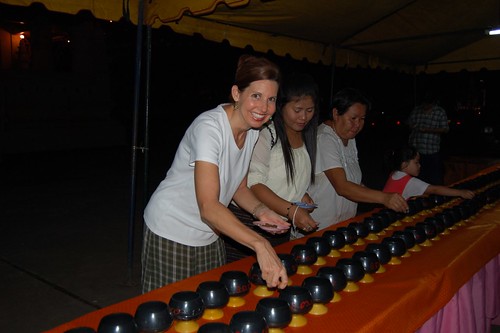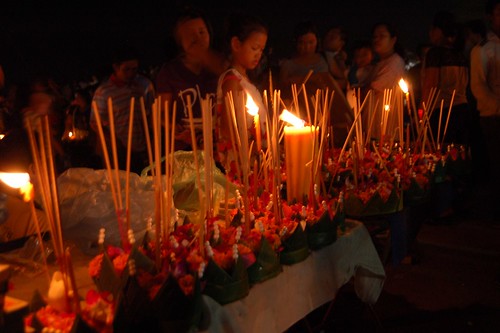One glimpse of the crowds at last year’s Boat Racing Festival was enough to send me straight home, where I watched the dragonboat races on TV. Later I regretted being such a coward. I vowed to step out of my comfort zone this year to experience one of Laos’ most highly-anticipated celebrations.
The holiday, which is tied to the lunar calendar, fell on a weekend this year. The boat races were scheduled for Sunday, and the Buddhist ritual of Loi Ka Thong would take place Saturday night.
I arranged to join some Lao friends for Loi Ka Thong. Websites, such as Laos Guide 999, set the stage for a tranquil, holy tradition.
Boun Awk Phansa is the last day of the Buddhist lent. It occurs in October, three lunar months after Khao Phansa on the 15th day of the 11th month of the lunar calendar. It is a day of many celebrations, most notably the boat race festival held in Vientiane.
On the first day at dawn, donations and offerings are made at temples around the country; in the evening, candlelight processions are held around the temples and it is the celebration of lai heua fai or Loi ka thong, when everyone sends small lighted ‘boats’ made of banana stems or banana leaves decorated with candles and flowers down the rivers.
These are said to pay respect to the Buddha and to thank the mother of rivers for providing water for our lives. Some believe that the lai heua fai procession is an act to pay respect to nagas that lives in the rivers, while others send the lighted boats down the river to ask for blessing and to float bad luck of the past year away enabling the good luck to flow in. Most towns with a river bank nearby will engage in this lovely ceremony. In bigger towns there are also processions of lighted boats, and the ceremony is more popular especially among young romantic couples. Villagers who live far from rivers set up model boats (made of banana stems) decorated with flowers and candlelight, while others simply light up some candles in front of their houses and do their little prayer wishing for good luck. This colorful rituals have been carried on by Lao people for thousands of years.
We were going to visit a temple, purchase a banana-leaf Ka Thong boat, join the procession to the Mekong and set sail our little boats after blessing the river and asking forgiveness for any eco-wrong-doings.
But first, we had to meet for Indian food in the heart of the festival chaos. The river road in downtown Vientiane was cut off from traffic and lined with stalls selling all sorts of wares usually purchased at a supermarket (and at the same prices). Massive speakers faced off, blaring what I can only assume were the qualities of the shampoo, toilet paper, cooking oil, or other products for sale at that particular stall. Vendors without a swanky audio system used static-y megaphones to promote the free samples, which flowed like … well, like juice, milk, whiskey, beer, soda and hand lotion. Complementing the cacophony, loudspeakers pounded out a steady bass beat with no discernable melody.
Tony and I parked where we always do, a few blocks from the action at Nam Phu Fountain, and then dove in to the melee. At this point, the river road was crowded but not unbearable. With so many storefronts blocked by the stalls, we occasionally had to pause to get our bearings. Finally we found the restaurant, Nazim, and scoffed at the option to eat outside. We eagerly plopped down at an indoor table, happy for a break from the noise (although we really couldn’t escape from the pulsing beat, which created ripples in our water glasses and reverberated through our bodies).
Soon we were joined by Lao friends Lae and Mai (and Mai’s friend, Khanha), as well as our school librarian, Jeannete, and her husband, Basim. I enjoyed the meal and the company, but I was itching to experience Loi Ka Thong.
Jeannete got a call during dinner from some cyclists riding through Laos. “We’re here!” they told her. She and Basim participate in an online organization that finds spare beds for people bicycling around the world. So they had to dash home. Tony also took off (and then came back to retrieve his keys, which he’d left on the table). Finally, the rest of the girls were ready to go.
I made the classic expat faux pas of assuming that because my friends were Lao, they certainly must know how this tradition works. Unfortunately, after wandering aimlessly for a while, I discovered that was not the case. Lae admitted she hadn’t participated in Loi Ka Thong since she was in high school. Mai said her family lived too far from the river, and they only had one bicycle, so participating in the ritual at the Mekong wasn’t feasible.
We ducked in to Wat Ong Teu, only to find we had missed the temple’s procession. Several monks were sitting behind a large table lined with metal bowls. Mai explained that you make a donation, collect a little plate of tiny coins and then drop one coin in each of the 99 bowls to ask for blessings. Cool. Of course, I was chatting the whole time I did it, so I kept losing track of where I had dropped my coins. “Is it bad karma to skip a bowl or to drop in more than one coin?” I asked. They just laughed at me.
Back on the river road, the crowd had reached maximum capacity. We slowly shuffled upstream as the Mekong River – blocked from our vision by market stalls, inflated bouncy castles, towering loudspeakers, and thousands of other pilgrims – rushed past us in the other direction. We reached one access point to the river, where a mob had bottlenecked with their Ka Thongs. The thought of joining them made my heart sink.
Lae received a call from Addie, who told us to keep walking. “It’s much less crowded up by the Mekong River Commission,” she said. And so we did. As we stumbled along, Lae shouted to me, “Now you see why I never do this!”
Eventually, we caught up with Addie, and sure enough, there was room to breathe. Addie had made her own Ka Thong (and many more, which she distributed to family members), so the rest of us purchased some from a vendor. Then we walked across a muddy stretch, descended some steep steps, scrambled down large wobbly rocks to the river’s edge and stepped on to a slippery floating dock. With my long temple-appropriate skirt tangling around my legs, camera dangling from my neck and one hand carrying my Ka Thong like a pizza, I felt quite relieved to make it that far in one piece.
The girls helped me light the candles and a sparkler on my Ga Thong, and then we each took turns offering a blessing to the river and asking forgiveness before reaching down to release our little boats. The strong current immediately swept them away, and the lights quickly blended together in the darkness.
Dripping with sweat, shaking from the treacherous climb back up to the river road, and still reeling from crowd-induced anxiety, I thanked my lovely friends for sharing their tradition with me. It wasn’t exactly what I expected, but I had the same experience as thousands of Lao people on this holy day, and that’s exactly what I had wanted.
It’s still early, and the crowds are thin.
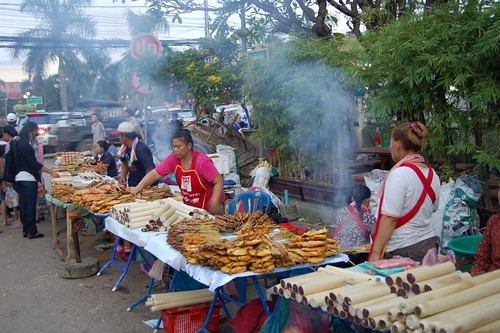
Back at the river road, it’s getting pretty busy.
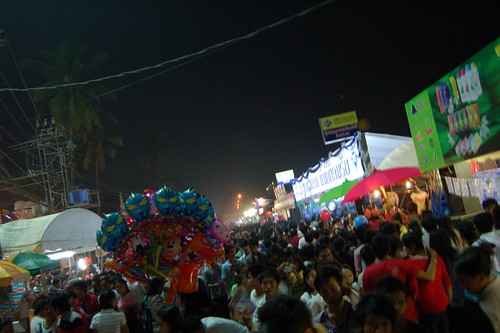
Finally, we meet up with Addie and enjoy a little elbow room.

Lanterns in the sky, Ka Thongs in the water.
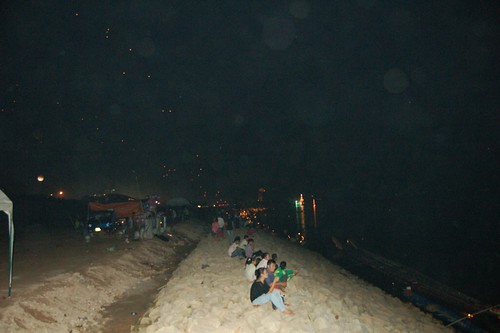
Mai says a little prayer before releasing her Ka Thong.
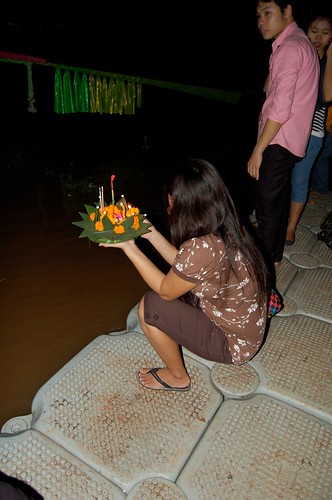
If you have a job that causes harm to the river, you must send out a bigger offering such as this.
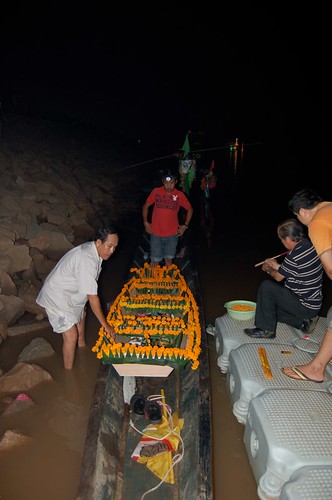
I couldn’t hold the camera steady on the bobbing dock, but I like this shot anyway.
